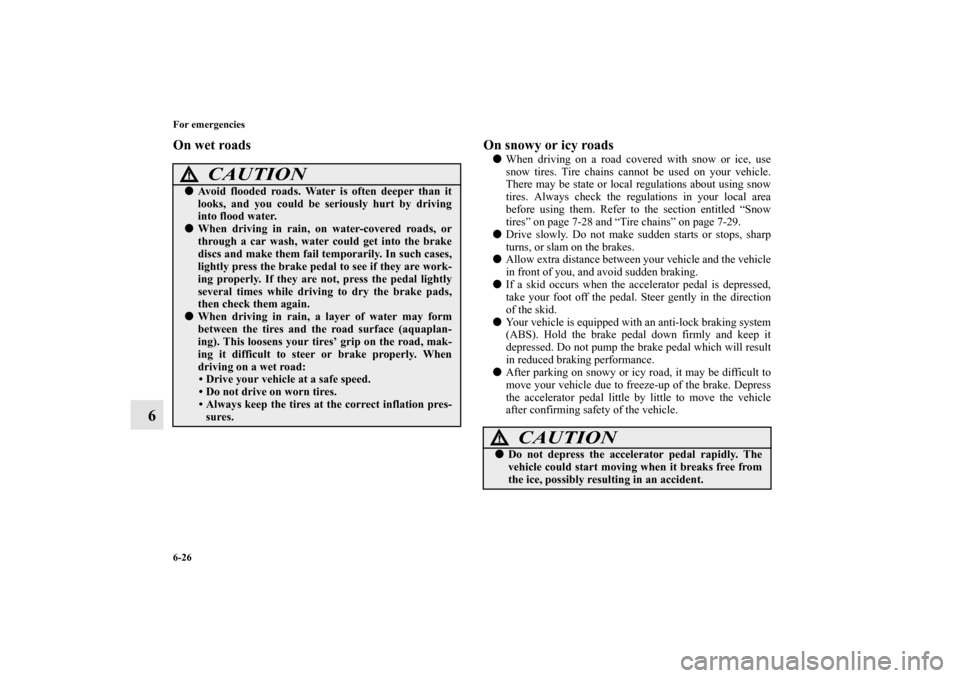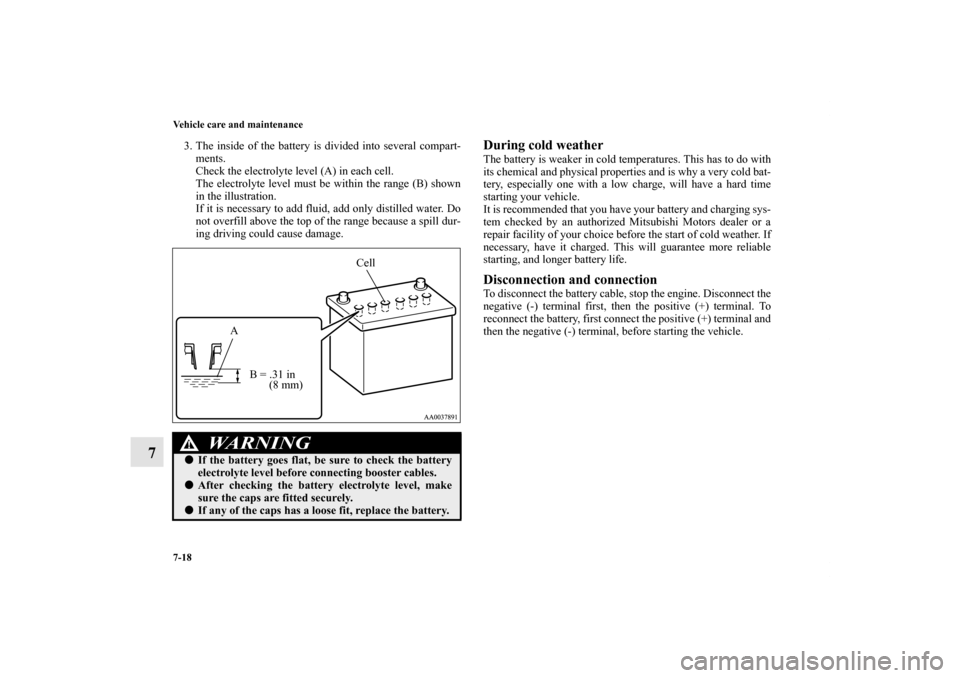Page 416 of 514

For emergencies
6-17
6
4. Insert the bar (D) into the wheel nut wrench (E). Then put
the end of the bar into the shaft’s jack end, as shown in the
illustration.
Slowly rotate the wheel nut wrench until the tire is raised
slightly off the ground surface.
5. Remove the wheel nuts with the wheel nut wrench, then
take the wheel off.
WA R N I N G
!�Stop jacking up the vehicle as soon as the tire is
raised off the ground. It is dangerous to raise the
vehicle any higher. �Do not get under your vehicle while using the jack. �Do not bump the raised vehicle or leave it sitting on
the jack for a long time. Both are very dangerous. �Do not use a jack except the one that came with your
vehicle. �The jack should not be used for any purpose other
than to change a tire.
�No one should be in your vehicle when using the
jack. �Do not start or run the engine while your vehicle is
on the jack.�Do not turn the raised wheel. The tires that are still
on the ground could turn and make your vehicle fall
off the jack.
CAUTION
!�Handle the wheel carefully when changing the tire,
to avoid scratching the wheel surface.
WA R N I N G
!
BK0121600US.book 17 ページ 2010年4月12日 月曜日 午前10時39分
Page 425 of 514

6-26 For emergencies
6
On wet roads On snowy or icy roads
�When driving on a road covered with snow or ice, use
snow tires. Tire chains cannot be used on your vehicle.
There may be state or local regulations about using snow
tires. Always check the regulations in your local area
before using them. Refer to the section entitled “Snow
tires” on page 7-28 and “Tire chains” on page 7-29.
�Drive slowly. Do not make sudden starts or stops, sharp
turns, or slam on the brakes.
�Allow extra distance between your vehicle and the vehicle
in front of you, and avoid sudden braking.
�If a skid occurs when the accelerator pedal is depressed,
take your foot off the pedal. Steer gently in the direction
of the skid.
�Your vehicle is equipped with an anti-lock braking system
(ABS). Hold the brake pedal down firmly and keep it
depressed. Do not pump the brake pedal which will result
in reduced braking performance.
�After parking on snowy or icy road, it may be difficult to
move your vehicle due to freeze-up of the brake. Depress
the accelerator pedal little by little to move the vehicle
after confirming safety of the vehicle.
CAUTION
!�Avoid flooded roads. Water is often deeper than it
looks, and you could be seriously hurt by driving
into flood water. �When driving in rain, on water-covered roads, or
through a car wash, water could get into the brake
discs and make them fail temporarily. In such cases,
lightly press the brake pedal to see if they are work-
ing properly. If they are not, press the pedal lightly
several times while driving to dry the brake pads,
then check them again. �When driving in rain, a layer of water may form
between the tires and the road surface (aquaplan-
ing). This loosens your tires’ grip on the road, mak-
ing it difficult to steer or brake properly. When
driving on a wet road:
• Drive your vehicle at a safe speed.
• Do not drive on worn tires.
• Always keep the tires at the correct inflation pres-
sures.
CAUTION
!�Do not depress the accelerator pedal rapidly. The
vehicle could start moving when it breaks free from
the ice, possibly resulting in an accident.
BK0121600US.book 26 ページ 2010年4月12日 月曜日 午前10時39分
Page 445 of 514

7-18 Vehicle care and maintenance
7
3. The inside of the battery is divided into several compart-
ments.
Check the electrolyte level (A) in each cell.
The electrolyte level must be within the range (B) shown
in the illustration.
If it is necessary to add fluid, add only distilled water. Do
not overfill above the top of the range because a spill dur-
ing driving could cause damage.
During cold weatherThe battery is weaker in cold temperatures. This has to do with
its chemical and physical properties and is why a very cold bat-
tery, especially one with a low charge, will have a hard time
starting your vehicle.
It is recommended that you have your battery and charging sys-
tem checked by an authorized Mitsubishi Motors dealer or a
repair facility of your choice before the start of cold weather. If
necessary, have it charged. This will guarantee more reliable
starting, and longer battery life.Disconnection and connectionTo disconnect the battery cable, stop the engine. Disconnect the
negative (-) terminal first, then the positive (+) terminal. To
reconnect the battery, first connect the positive (+) terminal and
then the negative (-) terminal, before starting the vehicle.
WA R N I N G
!�If the battery goes flat, be sure to check the battery
electrolyte level before connecting booster cables.�After checking the battery electrolyte level, make
sure the caps are fitted securely.�If any of the caps has a loose fit, replace the battery.
Cell
A
B = .31 in
(8 mm)
BK0121600US.book 18 ページ 2010年4月12日 月曜日 午前10時39分
Page 458 of 514

Vehicle care and maintenance
7-31
7 Wiper blades
N00940700011
Check the wiper blades occasionally. Clean them regularly to
remove deposits of salt and road film. Use a sponge or cloth
and a mild detergent or non-abrasive cleaner to clean the blades
and glass areas.
Replace the blades if they continue to streak or smear.NOTE�Do not run the wipers on dry glass for a long time. This
wears out the rubber and can scratch the glass.During cold weatherIf the blades are frozen to the windshield or rear window, do
not operate the wipers until the ice has melted and the blades
are freed, otherwise the wiper motor may be damaged.
Emission-control system maintenance
N00940800315
Your vehicle is equipped with an emission-control system that
meets all the requirements of the U.S. Environmental Protec-
tion Agency and Environment Canada. The emission-control
system is made of:
�a positive crankcase ventilation system
�an evaporative emission-control system
�an exhaust emission-control system
The maintenance services listed in the “WARRANTY AND
MAINTENANCE MANUAL” must be performed at the times
or mileages listed to keep the emission-control system working
properly. These, and all the other “general” maintenance ser-
vices listed in this manual, need to be performed to keep your
vehicle running properly and reliably.
You may need more frequent maintenance if you drive your
vehicle in harsh conditions such as dusty areas or do a lot of
start-and-stop driving.
To be sure the emission-control system works properly, have
your vehicle inspected and maintained by an authorized Mit-
subishi Motors dealer or a repair facility of your choice follow-
ing the schedule in the “WARRANTY AND MAINTENANCE
MANUAL”.
You should also have an inspection and service any time you
suspect a malfunction.
BK0121600US.book 31 ページ 2010年4月12日 月曜日 午前10時39分
Page 511 of 514

Alphabetical index
6Rearview mirror
Inside 3-30
Outside 3-32
Refrigerant (air conditioning) 5-26, 9-8
Replacement of light bulbs 7-44
Reporting Safety Defects 8-3
S
Safe driving techniques 4-5
Safety mechanism 3-27
Seat 2-2
Arm rest 2-11
Front seats 2-3
Head restraints 2-12
Heated seats 2-9
Rear seats 2-10
Seats and restraint systems 2-3
Seat belt 2-15
Adjustable seat belt shoulder anchor 2-21
Maintenance and inspection 2-35
Seat belts
Driver’s seat belt reminder/warning light 2-19
Front passenger seat belt warning light 2-20
Pre-tensioner and force limiter systems 2-23
Seat belt extender 2-22
Seat belt use during pregnancy 2-22
Service brake 3-53
Service precautions 7-2
Spark plugs 7-32Speedometer 3-78
Starting 3-37
Steering
Power steering fluid 7-16
,9-8
Tilt lock lever 3-29
Wheel lock 3-36
Steering wheel remote control switch 5-68
Stop lights
Bulb capacity 7-45
Replacement 7-51
Sun visors 3-194
Sunglasses holder 3-207
Sunroof 3-26
Safety mechanism 3-27
Sunshade 3-28
Timer function 3-26
Sunshade 3-28
Supplemental Restraint System 2-35
How the Supplement Restraint System works 2-39
Servicing 2-58
Warning light 2-44T
Tachometer 3-78
Tail lights
Bulb capacity 7-45
Replacement 7-51
Tank capacity 1-5
,9-8
Theft-alarm system 3-20
BK0121600US.book 6 ページ 2010年4月12日 月曜日 午前10時39分